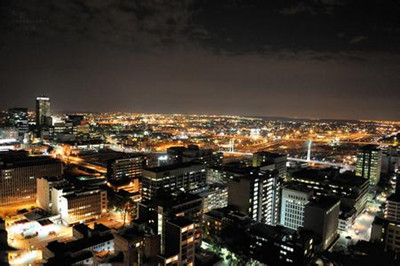南非城市現狀
Still worlds apart
支離破碎
Urban communities remain divided along racial lines. Can that be changed?
城市社區依然按照種族劃分。這種狀況是否有所轉變?
DRIVING throughSouth Africacan be like taking a disheartening trip back in time. Twenty years after introducing full democracy, the racist geography of the apartheid era is stubbornly unchanged.
在南非境內駕車,猶如一場時空倒退的旅行。二十年前,南非就倡導完全民主,二十年后,南非的種族歧視和種族隔離并未得到一絲一毫改變。
Most towns start with a collection of shacks, or perhaps rows of tiny matchbox houses, inevitably inhabited by blacks. A swathe of wasteland follows and then, further along, comes the town proper. Between the two, black people walk through fields or along roads—there are no proper pavements—or sometimes pile in and out of dilapidated minibus taxis en route from home to work. The effects of the Group Areas Act, which physically pushed non-whites to the margins of towns in 1950—at a distance, yet close enough to provide cheap labour—are still evident.
多數城鎮郊區都是成片破舊的、極其狹窄的房屋,這無疑是黑人的住所。周圍是一大片荒地,再遠處就是城區了。市區和郊區間并沒有人行道,出門工作時,黑人們只能穿過田地或者道路,有時候還要擠破爛不堪的面包車。1950年族群住區法將非白種人驅趕至城市邊緣地帶—有一定距離,但這距離也足夠提供廉價勞動力—這種狀況如今并無任何轉變。

In sprawlingJohannesburg, the biggest city inSouth Africaand its economic heartland, government officials are trying to break down this “spatial apartheid”. City planners have embarked on an ambitious project to “restitch”Johannesburg, aiming to narrow the great distances between the black majority's homes and their places of work. Getting communities to live side by side with each other will be no easy task. Income inequality and fear of violent crime have the effect of keeping races apart. Government efforts to provide electricity, water and housing to the poor have had the unintended consequence of strengthening apartheid geography by encouraging people to stay put. But the scheme can still make a big difference to people's lives.
約翰尼斯堡被分割的七零八碎,卻是南非最大的城市和經濟中心,政府官員們正在努力打破這種“種族隔離”狀態。城市規劃者們已經著手實施一項偉大工程—“重新使約翰尼斯堡成為一個整體”,縮短黑人住所和工作地點的距離。但是,讓人們挨著彼此近距離生活、挨著彼此并不容易。收入不均和對犯罪的擔憂也對種族隔離造成影響。政府努力給窮人們供應電力、水源和住房,鼓勵人們待在原地不動,這也造成了種族隔離的意外結果。但是這種體制也大大改變了人們的生活。
The flagship project inJohannesburgis a stylish pedestrian bridge that will link Alexandra township, where Nelson Mandela once lived and where the slum-like conditions haven't changed much since, with Sandton, the city's wealthiest suburb, where a statue of Mr Mandela is dwarfed by upscale shopping malls. These two areas are close as the crow flies, but cut off from each other by the country's busiest highway. The bridge should have great practical benefits. According to a traffic study, at least 10,000 people walk between Alexandra and Sandton every day. Construction is expected to start next month.
約翰尼斯堡大張旗鼓的工程就像個時尚的人行天橋,鏈接著曼德拉曾住過的亞歷山大小鎮,那兒的貧民窟什么的至今并未得到改變,該城鎮最富有的郊區桑頓屹立著曼德拉的雕像,但卻因一座座拔地而起的購物商場而顯的矮小。這兩個地方像兩條平行線,距離非常近,但卻被中間繁忙的高速公路隔離開來。該工程應該有些實際利益。根據一項交通調查,每天至少有10000人步行在亞歷山大和桑頓之間。預計下個月開始著手建設。
Johannesburg's “Corridors of Freedom” plan also includes a major expansion of the city's bus network and dedicated walking and cycling paths, linking areas slated for “mixed-use”development. Low-income workers typically spend many hours and big chunks of their salaries on transport.
約翰尼斯堡的“自由走廊”計劃也包括擴寬城市的公交網,建設人行道和自行車道,發展“共用空間”。尤其是工作時間長的低收入人群,交通費用較大。
The mayor, Parks Tau, speaks of “a comprehensive transformation of our spatial destiny and a break from our apartheid past.” The city's promotional material has a more pragmatic promise: “Gone will be the days of being forced to rise at dawn to catch a train, bus or taxi to a place of work.” Some residents in neighbourhoods along the planned corridors have complained of a lack of consultation from the city, and are fearful that crime may worsen as the masses pass by. But these changes are long overdue. A more efficient, people-friendlyJohannesburgwill be a far better city.
市長帕克斯在談到“我們的生存空間將會全方位轉型,擺脫過去的種族隔離狀態。”該城市的宣傳資料中有這么個務實的承諾:“壓迫的日子將一去不復返了,早起趕火車、公交、出租車去工作的日子也不再有了。” “自由走廊”附近的居民都抱怨與城區缺乏溝通,每天有大量人群路過怕不安全,加大犯罪率。但其實這些擔憂都是沒必要的,約翰尼斯堡的人們將會過上美好的生活。












